
The Marquesas Islands are a group of volcanic islands in French Polynesia, an overseas collectivity of France in the southern Pacific Ocean. Their highest point is the peak of Mount Oave on Ua Pou island, at 1,230 m (4,035 ft) above sea level.
Marquesan is a collection of East-Central Polynesian dialects, of the Marquesic group, spoken in the Marquesas Islands of French Polynesia. They are usually classified into two groups, North Marquesan and South Marquesan, roughly along geographic lines.

Mohotani is an uninhabited island southeast of Hiva Oa and east of Tahuata in the southern Marquesas Islands. It has an area of 15 km2. Much of the island's sparse vegetation has been destroyed by feral goats and sheep, to the extent that following its rare rains, the sea around it is stained red from runoff. Early reports describes the island as fertile, with forest and fields. When Thor Heyerdahl visited the island in 1938, there were only a few goats and remains of deserted huts and villages.
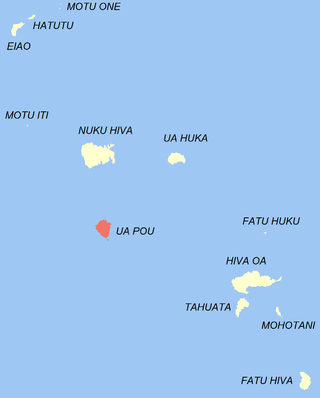
Ua Pou is the third largest of the Marquesas Islands, in French Polynesia, an overseas territory of France in the Pacific Ocean.

Ua Huka is one of the Marquesas Islands, in French Polynesia, an overseas territory of France in the Pacific Ocean. It is situated in the northern group of the archipelago, approximately 25 mi (40 km) to the east of Nuku Hiva, at 8°54′S139°33′W.
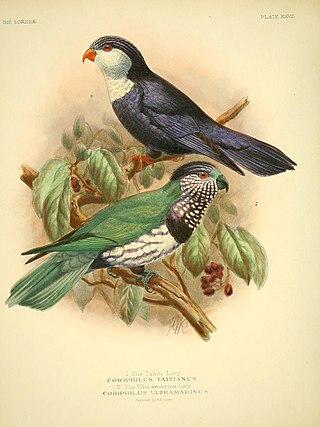
The ultramarine lorikeet is a species of parrot in the family Psittaculidae, endemic to the Marquesas Islands. Its natural habitats are subtropical or tropical moist lowland forest, subtropical or tropical moist montane forest and plantations. It is threatened mainly by introduction of the black rat and also by deforestation.
The Marquesan kingfisher or Marquesas kingfisher is a species of bird in the family Alcedinidae. It is endemic to French Polynesia. It is threatened by habitat loss and predation by introduced species, and is currently classified as Critically endangered, with fewer than 500 individuals left in the wild.

The black monarch is a species of bird in the family Monarchidae. It is found in New Guinea. Its natural habitats are subtropical or tropical moist lowland forest and subtropical or tropical moist montane forest.
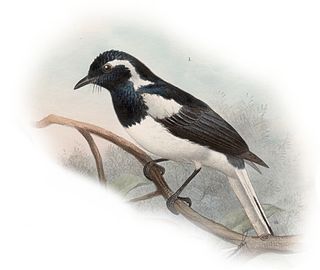
The Manus monarch, also called the Admiralty Islands monarch, the Admiralty monarch, the Admiralty pied monarch, the somber monarch and the unhappy monarch, is a species of bird in the family Monarchidae. It is endemic to the Admiralty Islands of Papua New Guinea.
The Eiao monarch is an extinct species of bird in the family Monarchidae. The species is sometimes considered to have been conspecific with the Iphis monarch. It was endemic to French Polynesia. Its natural habitats were subtropical or tropical dry forests, subtropical or tropical moist lowland forests, and subtropical or tropical moist shrubland.
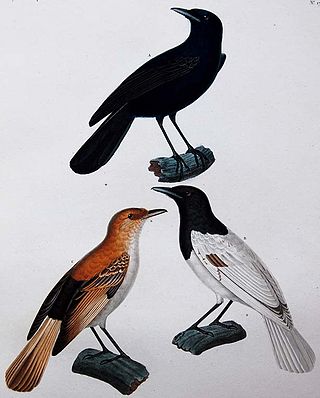
Pomarea is a genus of birds in the monarch flycatcher family Monarchidae. The genus is restricted to the islands of Polynesia. The monarchs of this genus are around 15–19 cm long and most have sexually dimorphic plumage.
The Iphis monarch, or Ua Huka flycatcher, is a species of bird in the family Monarchidae. It is endemic to French Polynesia. Its natural habitats are subtropical or tropical dry forests, subtropical or tropical moist lowland forests, subtropical or tropical moist shrubland, and plantations.
The Ua Pou monarch is a species of bird in the family Monarchidae, endemic to the French Polynesian island of Ua Pou. Its natural habitats are subtropical or tropical moist lowland forest, subtropical or tropical moist montane forest, and heavily degraded former forest.
The Nuku Hiva monarch, or Nukuhiva flycatcher, was a species of bird in the family Monarchidae. It was endemic to French Polynesia. Its natural habitats were subtropical or tropical moist lowland forests, subtropical or tropical moist montane forests, and heavily degraded former forest. It became extinct due to habitat loss and introduced predators. The last confirmed sighting was in the 1930s and a possible sighting was reported in 1975.
Epicephala spinula is a moth of the family Gracillariidae, one of the most primitive groups of ditrysian "micromoths". Within its family, it belongs to the subfamily Gracillariinae. Even though it was first scientifically studied in 1929, for many decades the specimens of this moth were mistaken for the related Australian species E. colymbetella, and their distinctness was only realized in 1986. It is found on the Marquesas Islands, where it occurs at least on Nuku Hiva, Ua Pou, and Fatu Hiva, and though little-known it is apparently not uncommon. The holotype specimen, a female, is USNM 100839.
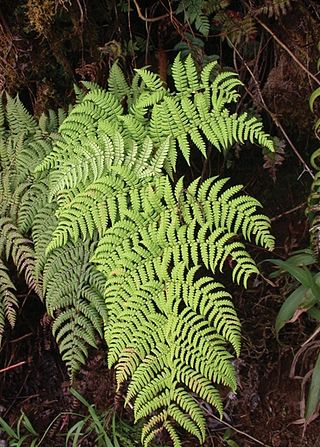
Dryopteris macropholis is a species of fern. It is distributed on the Marquesas Islands.
Libythea collenettei, the Marquesan snout butterfly, is a species of Nymphalid butterfly in the subfamily Libytheinae. The species was first described by Edward Bagnall Poulton and Norman Denbigh Riley in 1923. The specific name honours its original collector, Cyril Leslie Collenette, a member of the 1925 St George Expedition to French Polynesia. It is endemic to French Polynesia, L. collenettei is the only species of butterfly endemic to the Marquesas Islands.

The Marquesas tropical moist forests is a tropical and subtropical moist broadleaf forests ecoregion in the Marquesas Islands of French Polynesia.










